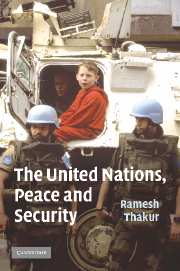Book contents
- Frontmatter
- Contents
- List of figures
- List of tables
- Foreword, Gareth Evans
- Acknowledgements
- Introduction
- PART I An international organisation for keeping the peace
- PART II Soft security perspectives
- PART III Hard security issues
- PART IV Institutional developments
- Conclusion: at the crossroads of ideals and reality
- Index
Conclusion: at the crossroads of ideals and reality
Published online by Cambridge University Press: 24 May 2010
- Frontmatter
- Contents
- List of figures
- List of tables
- Foreword, Gareth Evans
- Acknowledgements
- Introduction
- PART I An international organisation for keeping the peace
- PART II Soft security perspectives
- PART III Hard security issues
- PART IV Institutional developments
- Conclusion: at the crossroads of ideals and reality
- Index
Summary
The record of the United Nations shows a surprising capacity for institutional innovation, conceptual advances, policy adaptation and organisational learning. This can be shown with respect to peacekeeping and peace operations, human security and human rights, sanctions and the use of force, and so on. Yet in 2005, when this book was completed, the United Nations was an organisation in turmoil. On the one hand, there were efforts to initiate the most far-reaching, comprehensive and bold reforms in the UN's sixty-year history. On the other, the organisation was struggling to cope with a string of allegations of fraud and misconduct by foot soldiers and senior officials. A high-profile inquiry into the deeply damaging oil-for-food scandal fingered the son of the Secretary-General (SG) and faulted the SG for failure to conduct a proper investigation of possible conflict of interest. His former chief of staff was accused of shredding documents in relation to the scandal shortly after the inquiry was launched. The explanation that these were duplicates that had been destroyed in order to free up office space did not pass the ‘smell test’ for many American critics. The High Commissioner for Refugees had to resign in the aftermath of allegations of sexual harassment. The chief of the UN's internal oversight office – meant to oversee accountability and integrity in the organisation – left under a cloud with respect to oversight and recruitment lapses.
- Type
- Chapter
- Information
- The United Nations, Peace and SecurityFrom Collective Security to the Responsibility to Protect, pp. 343 - 369Publisher: Cambridge University PressPrint publication year: 2006



